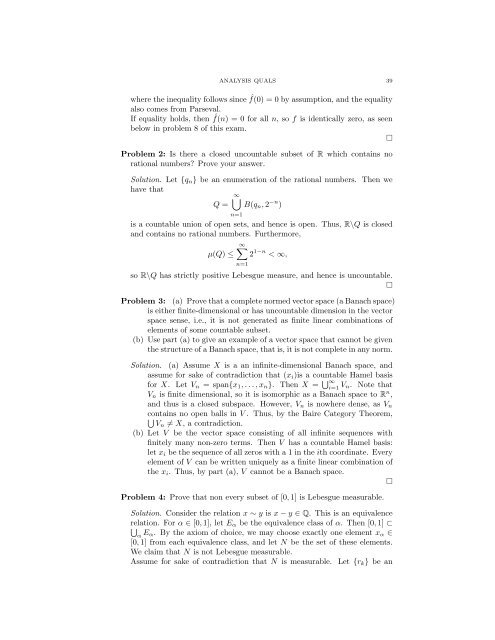ANALYSIS QUALIFYING EXAM PROBLEMS BRIAN LEARY ...
ANALYSIS QUALIFYING EXAM PROBLEMS BRIAN LEARY ...
ANALYSIS QUALIFYING EXAM PROBLEMS BRIAN LEARY ...
You also want an ePaper? Increase the reach of your titles
YUMPU automatically turns print PDFs into web optimized ePapers that Google loves.
<strong>ANALYSIS</strong> QUALS 39<br />
where the inequality follows since ˆ f(0) = 0 by assumption, and the equality<br />
also comes from Parseval.<br />
If equality holds, then ˆ f(n) = 0 for all n, so f is identically zero, as seen<br />
below in problem 8 of this exam.<br />
<br />
Problem 2: Is there a closed uncountable subset of R which contains no<br />
rational numbers? Prove your answer.<br />
Solution. Let {qn} be an enumeration of the rational numbers. Then we<br />
have that<br />
∞<br />
Q = B(qn, 2 −n )<br />
n=1<br />
is a countable union of open sets, and hence is open. Thus, R\Q is closed<br />
and contains no rational numbers. Furthermore,<br />
∞<br />
µ(Q) ≤ 2 1−n < ∞,<br />
n=1<br />
so R\Q has strictly positive Lebesgue measure, and hence is uncountable.<br />
<br />
Problem 3: (a) Prove that a complete normed vector space (a Banach space)<br />
is either finite-dimensional or has uncountable dimension in the vector<br />
space sense, i.e., it is not generated as finite linear combinations of<br />
elements of some countable subset.<br />
(b) Use part (a) to give an example of a vector space that cannot be given<br />
the structure of a Banach space, that is, it is not complete in any norm.<br />
Solution. (a) Assume X is a an infinite-dimensional Banach space, and<br />
assume for sake of contradiction that (xi)is a countable Hamel basis<br />
for X. Let Vn = span{x1, . . . , xn}. Then X = ∞<br />
i=1 Vn. Note that<br />
Vn is finite dimensional, so it is isomorphic as a Banach space to R n ,<br />
and thus is a closed subspace. However, Vn is nowhere dense, as Vn<br />
contains no open balls in V . Thus, by the Baire Category Theorem,<br />
Vn = X, a contradiction.<br />
(b) Let V be the vector space consisting of all infinite sequences with<br />
finitely many non-zero terms. Then V has a countable Hamel basis:<br />
let xi be the sequence of all zeros with a 1 in the ith coordinate. Every<br />
element of V can be written uniquely as a finite linear combination of<br />
the xi. Thus, by part (a), V cannot be a Banach space.<br />
<br />
Problem 4: Prove that non every subset of [0, 1] is Lebesgue measurable.<br />
Solution. Consider the relation x ∼ y is x − y ∈ Q. This is an equivalence<br />
relation. For α ∈ [0, 1], let Eα be the equivalence class of α. Then [0, 1] ⊂<br />
<br />
α Eα. By the axiom of choice, we may choose exactly one element xα ∈<br />
[0, 1] from each equivalence class, and let N be the set of these elements.<br />
We claim that N is not Lebesgue measurable.<br />
Assume for sake of contradiction that N is measurable. Let {rk} be an
















